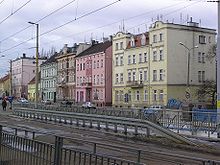Wrocław-Leśnica
Leśnica , formerly German Lissa , is a district in the west of the city of Breslau (Wrocław) . It is located around 12 km from the city center in the Fabryczna district . It was incorporated into Breslau in 1928.
history
In the Middle Ages, the Piast dukes built a courtyard at the ford of the Hohe Straße across the Weistritz , which was called "Lesnicz" or "Lesna" until the 15th century, which they used as a rest during their travels to Liegnitz . The first written records with the place names Lesnicz or Lesna do not come from the year 1227. The city must have been founded before 1261, from this point onwards the city was the seat of a bailiff .
By dividing the Duchy of Silesia in 1249 into four partial duchies, Lesnicz came to the Duchy of Wroclaw . As a result, the old rest area was no longer needed and therefore left to the bailiffs in 1289 together with the northwestern village of Muckerau. After the death of Duke Heinrich VI. Lesnicz fell together with the Duchy of Breslau in 1335 as a settled fiefdom to the Crown of Bohemia .
From 1339 Lesnicz belonged to wealthy Breslau merchants who did not promote the development of the city. In 1340 the city was deprived of the customs privilege that had existed since 1266. The Wroclaw patrician Michael Bankau built the Lissa manor and a castle for himself. In 1428 the city was destroyed by the Hussite Wars , and in 1465 it fell victim to another war. The Breslau patrician family Hornig, who had owned the estate since 1497, rebuilt the castle at the beginning of the 17th century. In 1611 Lissa became a free castle. The city burned down in 1633 during the Thirty Years War .
In 1651 ownership passed to Horatius von Forno. Subsequently there were several changes of ownership. From 1733 to 1752 these were the Knights of the Cross with the Red Star in Breslau, under whom the castle was rebuilt. In 1836 the Minister Carl von Wylich and Lottum acquired the castle; until 1945 it remained in the possession of the von Veltheim -Lottum family, who had become Putbus princes through inheritance .
The city sank in importance more and more, from 1736 it was only referred to as a town, fifty years later it was only a village with 323 inhabitants.
As a result of the First Silesian War , Lissa and most of Silesia fell to Prussia . In 1810 the road from Berlin to Breslau was completed, in 1846 the railway was built from Breslau via Lissa to Liegnitz. This did not result in a significant economic upturn.
Since 1873 the place was called "German Lissa" to distinguish it from the city of Lissa in the province of Posen . It was not until the end of the 19th century that companies emerged, including a. Tanneries and a fireclay factory , as well as housing estates for the workers. In 1928 it was incorporated into Breslau. During the Second World War , a satellite camp of the Groß-Rosen concentration camp was set up in Lissa .
After the conquest of Wroclaw by the Red Army in World War II , the Lissa district came under the administration of the People's Republic of Poland in May 1945 . Due to the expulsion and forced resettlement of the local population and the settlement of Poles in the years after the end of the war, the district, like the entire city, has been Polish- speaking since 1947.
Since 1950 leads from Leśnica a road train connection to the district Breslauer Pilczyce (Pilsnitz) , whereby a connection to the municipal tram network was produced. The castle burned down in 1953 and its restoration began in the 1960s.
Population development
1825: 427 inhabitants
1885: 2,063
1905: 4,128
Attractions
- Baroque palace, built 1735–1740 by the Lords of the Cross with the Red Star . In the first previous wooden building from the 1130s, the Wroclaw Duke Bolesław I died in 1201. In 1420 a brick complex was built and rebuilt in the Renaissance style in 1520–1550 . The castle accommodated numerous important guests, including the kings Matthias II , Friedrich II. After the battle of Leuthen , and Friedrich Wilhelm III. with his wife Luise . Since 1935 it has been renovated and redesigned by the then owner, Ludolf Baron von Veltheim-Lottum, changes from the 19th century have been eliminated. At that time, a cinema called "Schlosstheater" was built in the park by the architect Goetzsch.
traffic
The district is on the Breslau – Liegnitz railway line and has a train station. It is also connected to the city center by tram lines 3, 10 and 20 (as of August 2018).
Personalities
- Mortimer von Maltzahn (1793–1843), Prussian diplomat and foreign minister
- Alfred Hillebrandt (1853–1927), philologist
- Joachim Meisner (1933–2017), Archbishop of Cologne
literature
- Hugo Weczerka (Hrsg.): Handbook of the historical places . Volume: Silesia (= Kröner's pocket edition . Volume 316). Kröner, Stuttgart 1977, ISBN 3-520-31601-3 , p. 79 f.
Web links
Individual evidence
- ↑ Wolfgang Benz , Barbara Distel (ed.): The place of terror . History of the National Socialist Concentration Camps. Verlag CH Beck, Munich (9 volumes; 2005–2009).
- ↑ Isabell Sprenger: Groß-Rosen . A concentration camp in Silesia. Böhlau Verlag, 1997, ISBN 3-412-11396-4 .
- ↑ On the expulsions from Breslau see Gregor Thum: The foreign city. Breslau after 1945 , Siedler Verlag, Munich 2003, ISBN 3-570-55017-6 , pp. 130–150
Coordinates: 51 ° 9 ' N , 16 ° 52' E




